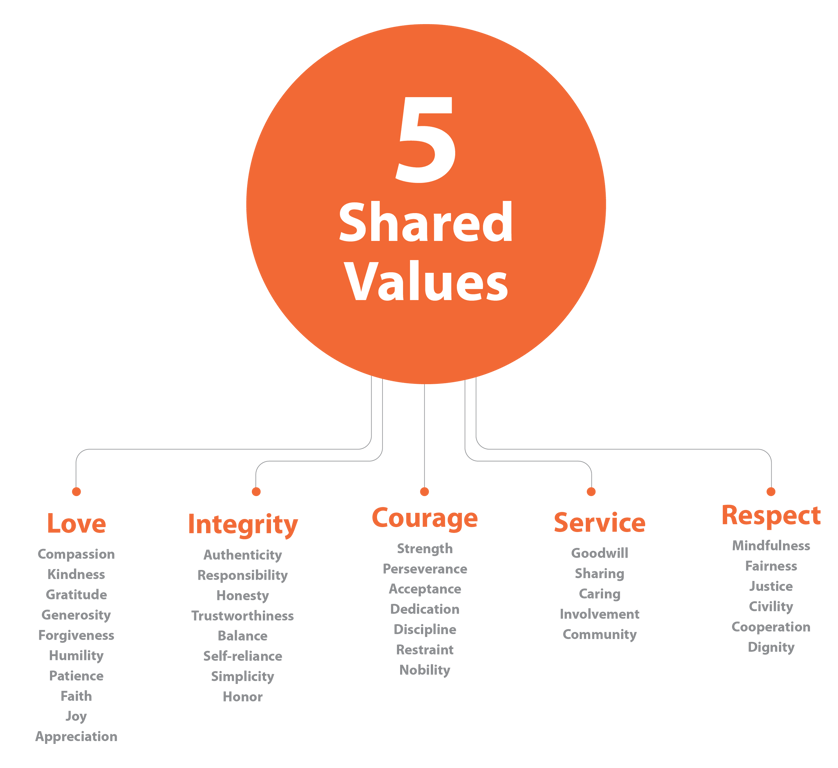The Symbiotic Age Is Taking Root—Who’s Already Living It Without Knowing?
FAQ Series #2: Who is this book for, and who am I to write it?
Frequently Asked Questions:
FAQ #1: The Symbiotic Age Has Begun—What If Love Was the Blueprint for Society?
FAQ #2: The Symbiotic Age Is Taking Root—Who’s Already Living It Without Knowing?
FAQ #3: From Separation to Symbiosis — How Do We Actually Begin to Build This?
NEW: FAQ POST 2 — Who is this book for, and who am I to write it?
I. PERSONAL VOCATION & STORY
1. WHO AM I TO WRITE THIS BOOK?
I wrote Birthing the Symbiotic Age for those who feel the painful disconnect between the world we know is possible in our hearts and the world we’re conditioned to survive in—a world shaped by competition, fragmentation, and fear. I’ve felt that ache since I was twelve.
For over fifty years, I’ve searched, wrestled, listened, and learned—across wisdom traditions, civic movements, and decades of experience building communities. What I offer here isn’t theory. It’s a living blueprint—a sacred pattern I’ve tried and proven and now feel called to share.
Along the way, I found a lineage of movements that weave inner spiritual growth with outer transformation—from Jesus to Dr. A.T. Ariyaratne, and through my own work in community life. My faith in Jesus anchors this path, even as I seek to honor others who walk different paths of Love. I hope this book speaks to that same longing in you.
2. WHOSE WORK HAS SHAPED MY OWN?
My work stands in a lineage of sacred patterning I call the Ancient Blueprint—a living design revealed through the life and teachings of Jesus, embodied in early Christian communities, echoed in Indigenous wisdom, and carried forward by figures like Gandhi, Dr. A.T. Ariyaratne, and the Czech Parallel Polis.
These exemplars root my work in a long, lived tradition of healing and sacred social renewal.
Each of these wove spiritual depth with practical action, building parallel structures grounded in Love, Virtue, and service. Their legacy reveals that cultural transformation doesn’t begin with ideology or reform, but with coherent lives and communities aligned with the sacred. Their work gives me courage: we’re not starting from scratch—we’re remembering a pattern that still lives in us, waiting to be reclaimed.
II. INTENDED AUDIENCE & INVITATION
3. WHO IS THIS BOOK BEING WRITTEN FOR?
This book is for those who sense the sacred at the heart of life and long to align their lives with it.
It’s for changemakers, caregivers, community and network builders, faith-rooted fellowships, local organizations, business owners, local governments, and bridge-builders who are already tending to the good in their communities, often unnoticed. You don’t need to be religious—but you do need to believe in something greater than yourself and that a more loving world is possible.
Birthing the Symbiotic Age uplifts the work of those already in service (and those just beginning the journey), especially the marginalized and invisible, and offers a shared pattern for weaving together the scattered threads of a culture already in the making.
4. WHY DOES THIS BOOK MATTER FOR SOMEONE WHO FEELS DISCONNECTED, SKEPTICAL, OR SPIRITUALLY HUNGRY?
This book is for those who sense that something deeper is possible but feel adrift in a fragmented world. If that’s you, you’re not alone.
If you long to revitalize your religious community in a “secular” age, have been turned off by religion, or feel burned out by institutional life, Birthing the Symbiotic Age offers a different path—one rooted in lived experience, relational wholeness, and a sacred pattern already woven into you. It’s not about belief or unbelief as labels—it’s about faithful expression: the kind of incarnational living where Divine Love takes form inside of us through generosity, compassion, justice, humility, hospitality, and care for others. This isn’t relativism, it’s about remembering what your soul already knows and living it tangibly, in relationship with others and the world.
The final section of the book offers a five-stage path to help you live this out—from healing yourself, to restoring relationships with family and neighbors, to aligning organizations, and finally building whole community networks around shared needs.
5. WHO FEELS SPIRITUALLY OR CULTURALLY LEFT OUT OF TODAY’S SOCIAL MOVEMENTS?
Many do—especially those from traditional religious backgrounds, Indigenous communities, or working-class contexts who feel unseen or misunderstood in secular, elite, or post-theistic spaces.
Movements often unconsciously silo themselves—using language or assumptions that create distance from people whose values they may otherwise share. Christians who speak in biblical terms, elders rooted in place-based wisdom, or those outside institutional power structures often sense they don’t “fit,” even when they share the same hopes for justice and healing. Meanwhile, terms like “Oneness,” while intended to unify, can feel abstract or impersonal to the theistic heart—where love of God and neighbor are lived relationships.
This book seeks to bridge—not flatten—worldviews. Symbiotic Culture honors difference without superiority, inviting a fuller circle to co-create sacred civic life together—what I call Symbiotic Kinship.
III. CULTURAL & POLITICAL CONTEXT
6. WHO HAS BEEN STRUCTURALLY EXCLUDED FROM SOCIETY — AND HOW CAN WE RESTORE SHARED DIGNITY?
While I acknowledge historic racism, sexism, and economic injustice, Symbiotic Culture frames the issue even more broadly. It invites a deeper reckoning with systemic disconnection—where spiritual, economic, and relational wounds all stem from a greater loss of sacred belonging and mutual recognition. This disconnection affects everyone, not just the historically marginalized.
The wound of separation is both personal and structural—alienating us from God, from neighbor, from Creation, and from our shared moral center. Healing means restoring all people to the circle of dignity, purpose, and mutual care.
This book seeks to reweave the social fabric not through ideology, but through a Culture of Connection—starting with those left out and extending to all who are willing to walk a more loving path forward. This journey home is ultimately spiritual in nature, touching every part of life.
7. IS THIS A POLITICAL BOOK?
Not in the partisan sense—but yes, it has profound political implications.
Whenever Divine Love becomes real, it transforms how we live together. This book doesn’t push a left or right agenda; it proposes a deeper reimagining of society rooted in sacred trust, shared Virtue, and mutual care. Jesus spoke often about how we live together—how what he called the Kingdom of Heaven is also rooted socially, morally, and embodied.
I call this vision a Parallel Polis: a new cultural and economic framework that transcends polarization and invites cooperation, coherence, and belonging. If politics means how we shape the common good, then this book is deeply political—but its path is relational, spiritual, and practical, not ideological or divisive.
And, it starts from the grassroots—with you, your family, your neighborhood, your organization, and your local region.
8. HOW DO I SEE THIS BOOK MAKING AN IMPACT?
Birthing the Symbiotic Age is meant to seed loving coherence in a fragmented world.
Its impact begins with personal metanoia—a turning of heart and mind toward Love—but expands through a vision of fractal empowerment: each person, organization, and community becoming a node of sacred transformation.
Just as in natural ecosystems, where symbiosis allows diverse organisms to flourish together, cultural symbiogenesis invites communities to retain their uniqueness while co-evolving through mutual care. Imagine 50,000 villages, towns, and cities—each embodying the Ancient Blueprint in their own way, yet connected in shared purpose.
This book doesn’t offer quick fixes or abstract theory. It invites a practical and sacred reorientation—rooted in Love, Virtue, and relational design. By connecting isolated efforts into living networks, it helps spread transformation from the ground up, renewing culture through Spirit-led, pluralistic participation.
IV. RELATIONAL INFRASTRUCTURE & SPIRITUAL DESIGN
9. WHO IS INCLUDED IN THE SACRED CIVIC INFRASTRUCTURE YOU ENVISION?
The Sacred Civic Infrastructure is for everyone, especially those who’ve been left out of current systems.
It’s designed to welcome bridge-builders, faith-rooted changemakers, and everyday people seeking meaning and belonging. These new relational infrastructures—what I call Symbiotic Networks—must include the poor, the disillusioned, the faithful, the secular, the spiritual-but-not-religious, and those weary of division.
Wholeness requires that we consciously reconnect across difference—not by erasing distinct traditions, but by building trust across communities through shared moral purpose. The invitation isn’t to agree on metaphysics, but to collaborate on Love in action—where justice, care, and sacred responsibility become the scaffolding for a new society that serves all.
10. WHO ARE THE “LITTLE PLATOONS” OR MEDIATING STRUCTURES THAT HOLD SOCIETY TOGETHER?
The “little platoons” are the small, relational groups—families, churches, block associations, business networks, local cooperatives, charities, mutual aid networks, and civic circles—that serve as the bridge between personal faith and public life. They are intermediary spaces of trust between individuals and larger forces like the State or market.
They’re where conscience becomes culture, where Love becomes law—not by coercion, but through belonging. These mediating structures are neither top-down institutions nor isolated individuals. They’re moral ecosystems where Virtue is practiced and passed on, and where trust networks are built.
In Symbiotic Culture, we see these relational containers not just as service hubs, but as sacred scaffolds—spaces where cultures, economies, and politics are re-patterned from the ground up, guided by Love and mutual care.
11. WHO CAN HELP RE-WEAVE THE MORAL FABRIC OF SOCIETY?
The moral thread endures in ordinary people with extraordinary integrity—parents, pastors and laity, teachers, healers, neighbors, business owners, and organizers quietly laboring for the common good. They may not hold institutional power, but they carry moral authority.
In a culture frayed by cynicism and division, these individuals live by conscience and lead with humility, courage, and compassion. They are forming Networks of Virtue—relational spaces where shared values are practiced across lines of belief. This work doesn’t demand moral uniformity, but a commitment to moral ecology: spaces where Virtue is not just discussed but lived.
It is through these sacred social fabrics that love can be sustained in the midst of different worldview frames.
12. WHO ARE THE BRIDGE-BUILDERS AND MOVEMENTS ALREADY STARTING TO EMBODY SYMBIOTIC CULTURE?
They’re the unsung heroes—teachers building trust across divides, pastors welcoming all without losing their spiritual center, organizers linking faith with justice, business owners, local nonprofits and civic groups, local food systems, and neighbors planting gardens and hosting circles.
You’ll find them in diverse movements already tending the soil: faith-rooted communities, regenerative culture advocates, purpose-driven entrepreneurs, civic bridge-builders, creation care networks, new economy and localization efforts, and those quietly nurturing the commons and civil society. Many don’t use the language of Symbiotic Culture—but they’re living it the best they can, often isolated by the Culture of Separation.
This book names what they already do and offers a deeper framework for connection—so they can see each other, draw strength from shared purpose, and build something new together while the old system passes away naturally.
13. WHO ARE YOUR SPIRITUAL ANCESTORS, AND WHY DO YOU REFER TO IT AS A LINEAGE?
I draw from a lineage I call the Ancient Blueprint—a sacred design carried not by creed, but by lived experience and communion. Jesus is central for me, revealing Divine Love through a way of life: humble, virtuous, relational, and just. But that same pattern shows up in other traditions—Gandhi’s and Dr. Ari’s village-based Sarvodaya networks, the Czech Parallel Polis, and Indigenous wisdom rooted in kinship with Earth.
I speak of lineage beyond specific traditions because sacred coherence doesn’t belong to one stream. It arises wherever people embody Love, truth, and freedom in community. These spiritual ancestors show that the deepest transformation is always relational—and always real.
V. SAFEGUARDS & SPIRITUAL HUMILITY
14. WHO GETS TO DEFINE “SPIRITUAL MATURITY” IN SYMBIOTIC CULTURE?
No single person or institution defines it. In Symbiotic Culture, spiritual maturity isn’t measured by belief system, social status, or spiritual self-image—it’s revealed through relationship. Are we becoming more loving, humble, compassionate, and generous? Are we more able to hold complexity without seeking control?
True maturity also shows up as the capacity to hold space for the whole community—not just those like us. It’s the willingness to expand beyond our group identity, to walk with those we once avoided, and to consciously widen our sphere of care in Symbiotic Kinship.
Rooted in the Christian pattern of self-giving love, this book honors diverse paths. Maturity isn’t about superiority—it’s about integrating self, Spirit, and neighbor into a life of coherence, courage, and connection.
Maturity is always relational—or it isn’t real.
15. WHO ENSURES THAT SYMBIOTIC CULTURE REMAINS OPEN AND NOT “ONE RING THAT RULES THEM ALL”?
We all share that responsibility. That’s why relational design—not ideology—is at the heart of Symbiotic Culture.
By anchoring every practice in mutual recognition, pluralism, and moral humility, we protect against domination—even subtle spiritual superiority. Symbiotic Circles are built as containers rather than control systems. Their power lies not in uniformity, but in coherence: allowing different worldviews to find common purpose through shared Virtues and sacred service. This culture grows not through control, but through communion.
Stay tuned for the next FAQ instalment. Please feel free to reply to this message or make comments.
In the meantime, please check out these relevant posts:
The first is about the origins of the Parallel Polis (society). The second and third posts are the Preface and the Introduction from my upcoming book, Birthing the Symbiotic Age.
Living in Truth: Building a Parallel Polis Within a Spiritually Hostile Regime, Chapter 12, Part 5
Welcome to the Birthing the Symbiotic Age Book!
Living Between Worlds: with Audio
Dear readers, I am very excited to give you a sneak peek of the preface from my upcoming book, Birthing the Symbiotic Age. For many of you, it has been a journey of more than a year, as I have been sharing the first three of the four sections of the book right here on Substack.
The Turning Point We’ve Been Waiting For
Dear readers, I am happy to share a sneak peek of the Introduction from my upcoming book, Birthing the Symbiotic Age. I have been releasing the first three quarters of the book freely here on Substack, starting in January 2024!








